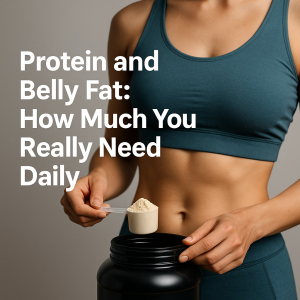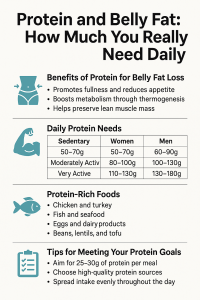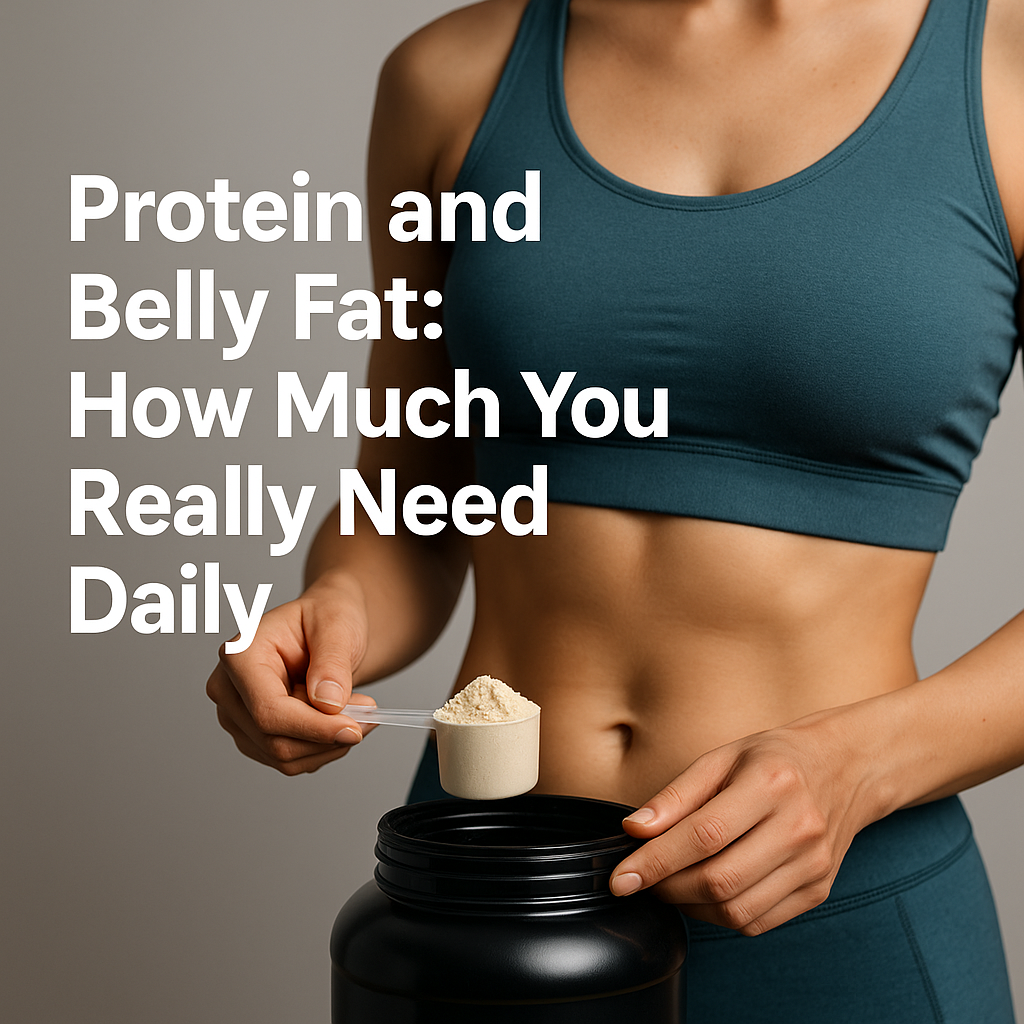Protein and Belly Fat: How Much You Really Need Daily
When it comes to losing stubborn belly fat, one nutrient consistently stands out — protein. But how much do you actually need each day to see results? Understanding the link between protein and belly fat can help you lose inches, boost metabolism, and maintain a healthy, toned body. Let’s dive deep into the science of protein and discover how to balance it for effective, lasting fat loss.
Understanding the Connection Between Protein and Belly Fat
What Is Belly Fat and Why It’s So Hard to Lose

Belly fat, or visceral fat, sits around your abdominal organs and is notoriously difficult to burn. It’s linked to insulin resistance, hormonal imbalances, and inflammation — all of which can slow fat loss. This type of fat is often the last to go, even with dieting.
How Protein Helps Reduce Belly Fat Naturally
Protein is your fat-loss ally. It keeps you full longer, stabilizes blood sugar levels, and boosts your metabolism through a process called thermogenesis — where your body burns more calories digesting protein compared to fats or carbs. Consuming enough protein daily helps preserve lean muscle, which in turn burns more calories at rest.
The Science: How Protein Affects Metabolism and Fat Burning
Protein’s Thermic Effect and Calorie Burning
The thermic effect of food (TEF) refers to how much energy your body uses to digest, absorb, and process nutrients. Protein has the highest TEF — around 20–30% of its calories are burned just during digestion. This means eating 100 calories of protein only provides about 70–80 usable calories.
How Protein Regulates Hunger Hormones and Cravings
Protein reduces hunger by lowering ghrelin (the hunger hormone) and increasing peptide YY, which promotes satiety. Studies show that increasing protein intake by just 10–15% can lead to a spontaneous reduction in calorie intake — helping you lose belly fat without constant hunger.
The Role of Protein in Preserving Lean Muscle Mass
When you’re in a calorie deficit, your body risks breaking down muscle tissue for energy. Consuming adequate protein preserves muscle while encouraging fat burning — particularly important for reducing belly fat while maintaining tone.
How Much Protein Do You Really Need Daily?
Recommended Protein Intake by Gender and Activity Level
| Activity Level | Women (grams/day) | Men (grams/day) |
|---|---|---|
| Sedentary | 50–70g | 60–90g |
| Moderately Active | 80–100g | 100–130g |
| Very Active or Strength Training | 110–130g | 130–180g |
Calculating Your Ideal Daily Protein Needs
A general rule: consume 1.2–2.2 grams of protein per kilogram of body weight.
Example: A 70kg (154lb) person aiming for fat loss should eat 84–154 grams of protein per day, depending on activity level.
Protein Timing and Distribution Throughout the Day
For optimal metabolism, spread your protein evenly:
-
Breakfast: 25–30g
-
Lunch: 25–35g
-
Dinner: 30–40g
-
Snacks: 10–20g each
This keeps muscle protein synthesis active and hunger in check.
Best Protein Sources for Belly Fat Reduction
Animal-Based Protein Options
-
Chicken breast, turkey, lean beef
-
Fish (salmon, tuna, cod)
-
Eggs and egg whites
-
Greek yogurt and cottage cheese
Plant-Based Protein Sources
-
Lentils, chickpeas, quinoa
-
Tofu, tempeh, edamame
-
Hemp seeds, chia seeds, and nuts
Protein Supplements: Should You Use Them?
If you struggle to meet protein needs, a whey, casein, or plant-based protein powder can help fill the gap — especially post-workout.
Common Myths About Protein and Belly Fat
Myth 1: More Protein Always Means More Fat Loss
Too much protein can be stored as fat if total calories are excessive. Balance is key.
Myth 2: Protein Makes You Bulky
Protein supports lean muscle—not bulk—unless combined with heavy strength training and high calorie intake.
Myth 3: You Can Get Enough Protein Without Planning
Most people underestimate their protein intake. Without planning, it’s easy to fall short, especially on a plant-based diet.
Sample High-Protein Meal Plan for a Flatter Belly
| Meal | Example | Protein (g) |
|---|---|---|
| Breakfast | Scrambled eggs with spinach + oatmeal | 30g |
| Snack | Greek yogurt with chia seeds | 15g |
| Lunch | Grilled chicken salad with quinoa | 35g |
| Snack | Protein shake or nuts | 20g |
| Dinner | Baked salmon with vegetables | 40g |
Signs You’re Not Eating Enough Protein
-
Constant hunger or cravings
-
Loss of muscle tone
-
Fatigue and low energy
-
Hair loss or brittle nails
-
Difficulty losing belly fat
If you notice these signs, increase your protein gradually and track your intake for a week.
FAQs About Protein and Belly Fat

Q1: Can eating too much protein cause belly fat?
Only if you consume more calories than your body burns — excess energy, from any source, can be stored as fat.
Q2: What’s the best time to eat protein for fat loss?
Distribute it evenly throughout the day, but prioritize morning and post-workout meals.
Q3: Do protein shakes help reduce belly fat?
Yes, when used to meet daily protein goals without adding excess calories.
Q4: Can vegetarians lose belly fat effectively?
Absolutely. Focus on lentils, tofu, quinoa, and plant-based protein powders.
Q5: How long does it take to see results?
Most people notice reduced bloating and better tone within 2–4 weeks of consistent protein intake and clean eating.
Q6: What’s the biggest mistake people make?
Skipping breakfast protein — it sets the tone for hunger and cravings later in the day.
Conclusion: Finding Your Protein Balance for Sustainable Fat Loss
Protein isn’t a magic pill, but it’s the most powerful nutrient for fat loss — especially around your belly. By eating the right amount daily, spreading it evenly across meals, and combining it with regular exercise, you’ll naturally reduce belly fat, maintain lean muscle, and feel stronger than ever.
🔗 External Link: Learn more about protein intake and metabolism from Harvard Health Publishing.


